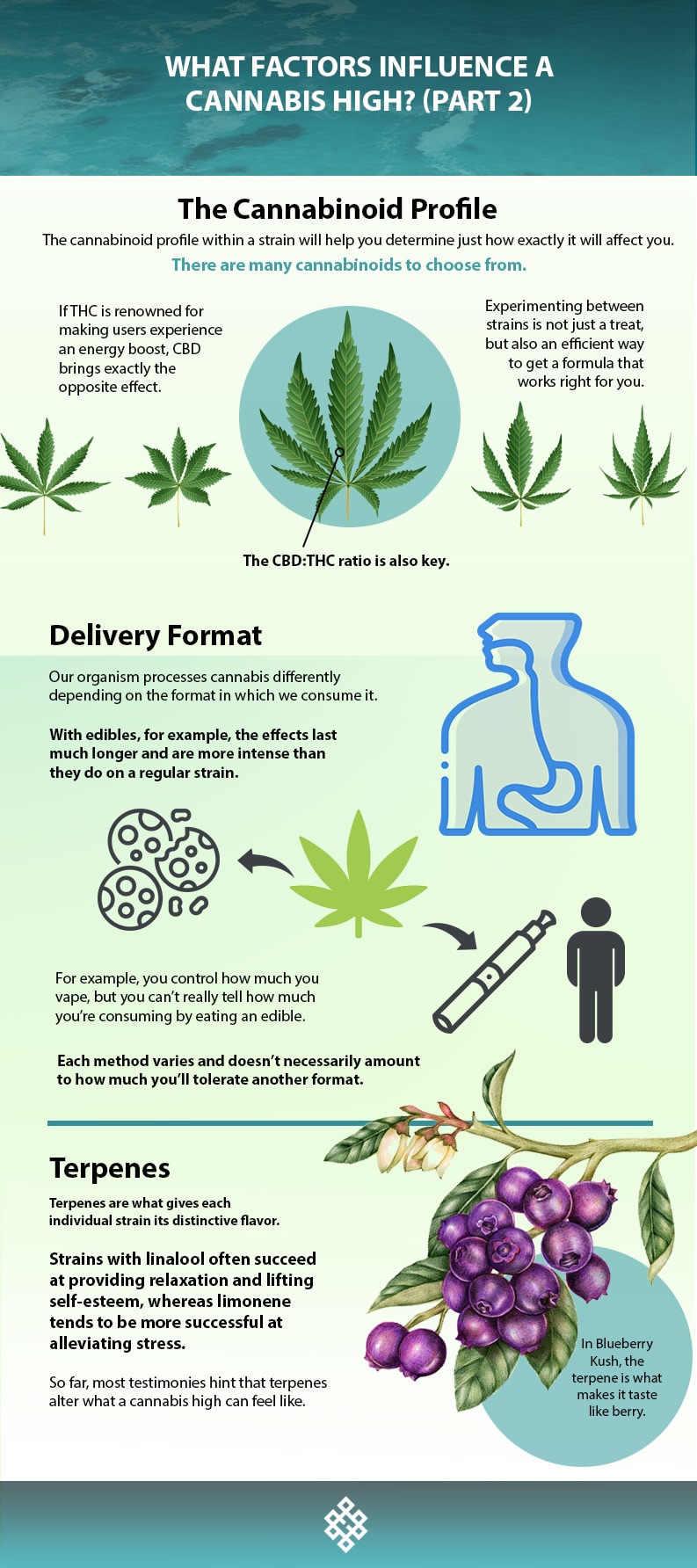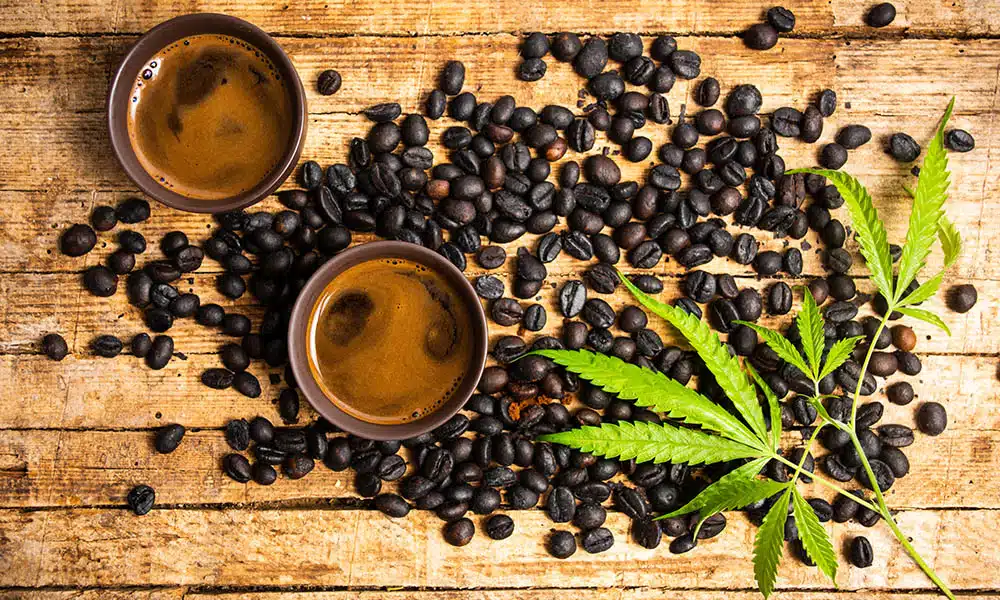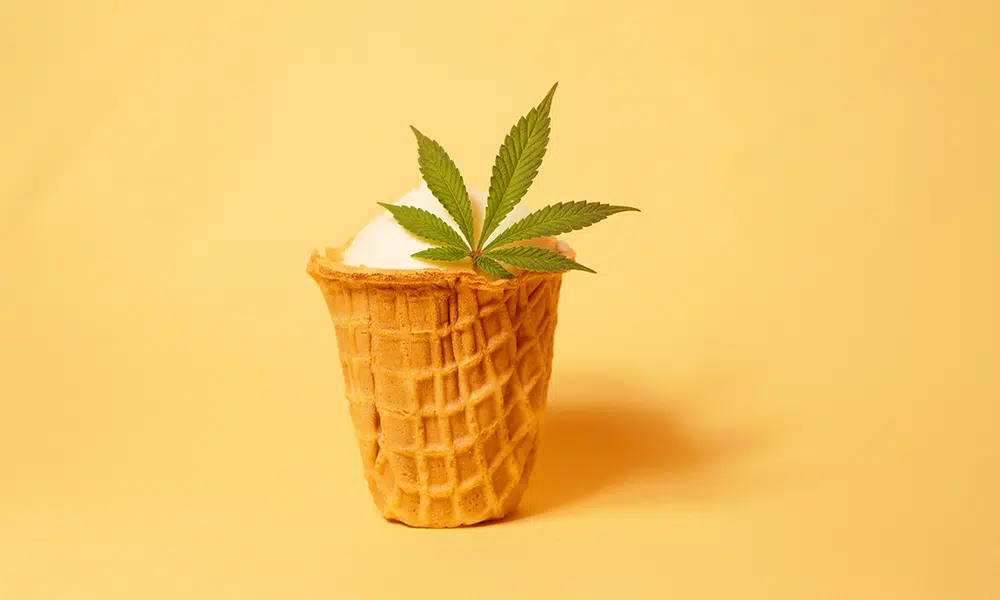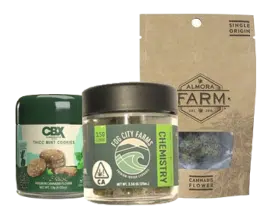There are many factors to consider when consuming cannabis in regards to how good a high can be. In Part 1 of this article, we looked at how cannabis tolerance, dosage and consumption environment can result in entirely different experiences than those we’re used to having. However, the list hardly ends there. The many factors to consider that can make a high pleasant enough are both internal and external.
Professionals from the cannabis industry continuously strive to making formulas and presentations work better for their customers. However, in the end, it all depends on each person’s individual taste and experience.
Becoming familiar with what makes a cannabis compound work its magic also means going through the tiny ingredients, such as terpenes, and appreciating their individual properties. Understanding what makes a cannabinoid profile work will separate a good user from an amateur, and telling a delivery method from another will prevent an unwanted overdose. Knowing these will make a huge difference, and enable you to find what you’re looking for faster.
So, without further ado, let’s take a close look at some of the most influential factors that can make a cannabis high a superb time or a regrettable downer.
The Cannabinoid Profile
Throughout the cannabis industry, most consumers and professionals consider that strains are the go-to standard for measuring quality and impact. More specifically, the cannabinoid profile within a strain will help you determine just how exactly it will affect you. Not all strains and formulas have the same effect on the people who consume them. For example, if a user chooses to go for a THC strain, they might enjoy its stimulating properties. But for others, THC is usually too intense and makes them feel anxious and even tired.
However, there are many cannabinoids to choose from. If THC is renowned for making users experience an energy boost, CBD brings exactly the opposite effect. Furthermore, we are now acquainted to more than one CBD-infused formula, so users looking forward to experimenting or getting a wider sense of what cannabis can do will make the most from it. The diversity that can be found in cannabinoid profiles is potentially endless. Experimenting between strains is not just a treat, but also an efficient way to get a formula that works right for you.
Getting curious about the effects of each cannabinoid will let you know how effective the high they bring is. After experimenting, you will know the strain’s composition better and this will come in handy when procuring the perfect high.
There are a few other factors that you may wish to consider when assessing the cannabinoid profile. For example: take a close look at the CBD:THC ratio of the strain. This is important, since CBD can be enhanced by the amount of THC presence within the formula. If you dismiss THC because it makes you feel anxious, you might be turning off a relieving THC-infused strain with a different compound ratio. So again, experimenting until finding the perfect balance is key in a cannabinoid profile.

Delivery Format
The cannabis industry is known for achieving a wide array of cannabis presentations. Whether it’s smoking, edibles or vaping, these are all ways cannabis can be consumed. However, all of these formats are different. Most users find that consuming an edible and vaping a cannabis compound have different ways of working in their body. From a chemical point of view, our organism processes cannabis differently depending on the format in which we consume it. Depending on which cannabis method you use, you might also be consuming a different amount than you’re used to. With edibles, for example, the effects last much longer and are more intense than they do on a regular strain.
There are cannabis formats on which controling the dose is easier. For example, you control how much do you vape, but you can’t really tell how much you’re consuming by eating an edible. On a sidenote, the dose is stronger in a dabbing oil format than in a puffed joint. Professionals from the cannabis industry consider that measuring with a joint is not only easier than to do it with a vape, but that it is also much more practical. If you want your high to be as pleasant and effective as possible, you need to consider that these factors are very influential.
Long story short, you should strive to testing your own tolerance limits per delivery format. Each method varies and doesn’t necessarily amount to how much you’ll tolerate another format.
Terpenes
Last but not least, we must consider the monumental influence that terpenes have in a cannabis experience. Whether you’re an experienced user or a first-timer, there’s a good chance you’re already familiar with what terpenes are, even if you don’t quite know them by name.
Terpenes are what gives each individual strain its distinctive flavor. It’s like the special scent that gives each compound its name. In Blueberry Kush, the terpene is what makes it taste like berry. The same goes with the fueling sensation that can be found in a Sour Diesel mix. Few cannabis experts, however, are sure that terpenes are as influential to a good high as they might seem. In order to ascertain this, more studies will have to be conducted.
So far, most testimonies hint that terpenes alter what a cannabis high can feel like. Strains with linalool often succeed at providing relaxation and lifting self-esteem, whereas limonene tends to be more successful at alleviating stress. When looked at the big picture, strains such as Lavender are famous for the properties linalool has. So, it goes from there. Linking the strains to specific results will make it easy for you to tell which terpenes work best.
The cannabis industry will likely be subjected to more studies in the following years. So, there’s still hope that we can discover what the beneficial effects of terpenes are. This will probably lead to the users getting to know them better, and choosing the terpenes more fitting to their taste.





















